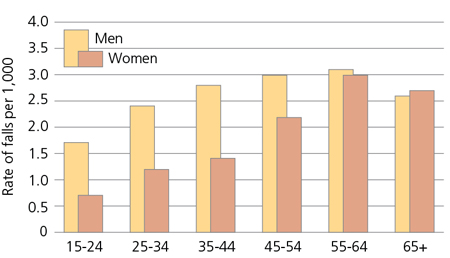Rate of falls per 1,000 workers, by age and sex, BC, 2008
In brief
- There is a growing recognition that the risks of work injury may differ for men and women by occupational exposure and be influenced by non-work factors. Moreover men and women may experience different workers’ compensation and return to work outcomes based on gender (i.e., social expectations and role differences between men and women) and sex (i.e., biological differences between males and females).
- For example, our research examining the relationship between shift work and work injury found that women are at a higher risk of injury when working in night and rotating shifts compared to women working during the day.
- Our research on serious injuries found that women 55 to 64 years old are three times more likely to experience a severe fall than women 15 to 24 years old and women working in health care are three to four times more likely to incur a serious injury as men in that field.
- Understanding how gender and sex can influence the risk of work injury and return to work is key to developing effective injury prevention and workers’ compensation policy, especially given that women now make up half the labour force in Canada and that both men and women are working in greater numbers in non-traditional occupations.
Next steps
We are examining differences in the risk of injury for men and women by occupational and industrial setting and gender differences in health and return to work outcomes among injured workers.
CIHR Chair in Gender, Work and Health
In February 2013 Partnership Co-Lead Mieke Koehoorn was named a CIHR Chair in Gender, Work and Health. Her Chair supports Partnership projects investigating gender and sex differences in work injury and illness rates in BC, and gender and sex differences in work disability outcomes across compensation systems in Canada and internationally. More…
Related publications
Differences between men and women in their risk of work injury and disability: A systematic review
Journal article
Biswas A, Harbin S, Irvin E, Johnston H, Begum M, Tiong M, Apedaile D, Koehoorn M, Smith P.
Am J Ind Med. 2022 Jul;65(7):576-588. doi: 10.1002/ajim.23364. Epub 2022 May 16.
Impact of anxiety and depression disorders on sustained return to work after work-related musculoskeletal strain or sprain: a gender stratified cohort study
Journal article
Jones AM, Koehoorn M, Bültmann U, McLeod CB.
Scand J Work Environ Health. 2021 Mar 21:3951. Online ahead of print.
Prevalence and risk factors for anxiety and depression disorders in workers with work-related musculoskeletal strain or sprain in British Columbia, Canada: a comparison of men and women using administrative health data
Journal article
Jones AM, Koehoorn M, Bültmann U, McLeod CB. 2021 Jan 22;oemed-2020-106661. Online ahead of print.
Men and women at work in Canada, 1991–2016
Journal article
Quinn E, Harper A, Rydz E, Smith P, Koehoorn M, Peters C.
Labour & Industry. 2021 Jan 20.
Does gender/sex matter for risk and compensation of activity-related soft tissue disorders?
Research brief investigating gender/sex-based differences in activity-related soft tissue disorders among workers in BC. July 2020.
Does gender/sex matter for risk and compensation of non-traumatic, work-related hearing loss?
Research brief investigating of gender/sex-based differences in work-related hearing loss among workers in BC. July 2020.
Is gender/sex associated with risk and compensation of work-related concussions?
Research brief investigating of gender/sex-based differences in work-related concussions among workers in BC. July 2020.
Gender Differences in Surgery for Work-Related Musculoskeletal Injury: A Population-Based Cohort Study
Journal article
Jones AM, Koehoorn M, McLeod CB.
Healthcare Policy. 2020 Feb;15(3):47-62.
Do Differences in Work Disability Duration Between Men and Women Vary by Province in Canada?
Journal article
Macpherson RA, Koehoorn M, Fan J, Quirke W, Amick BC, Kraut A, Mustard CA, McLeod CB.
J Occup Rehabil. 2019 Sep; 29(3):560-568.
Age, sex, and the changing disability burden of compensated work-related musculoskeletal disorders in Canada and Australia
Journal article
Macpherson R, Lane T, Collie A, McLeod C.
BMC Public Health. 2018;18:758.
Measuring gender when you don’t have a gender measure: constructing a gender index using survey data
Journal article
Smith P, Koehoorn M.
Int J Equity Health. 2016 May 28;15(1):82.
Gender Inequalities in Access to Health Care among Adults Living in British Columbia, Canada
Socías ME, Koehoorn M, Shoveller J.
Womens Health Issues. 2016 Jan-Feb;26(1):74-9.
Descriptive epidemiology of serious work-related injuries in British Columbia, Canada
Journal article
Fan J, McLeod C, Koehoorn M. PLoS ONE. 2012; 7(6): e38750.
Media release.
Exposure assessment in epidemiology: does gender matter?
Journal article
Kennedy S, Koehoorn M. American Journal of Industrial Medicine. 2003; 44(6):576-583.

